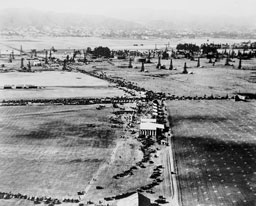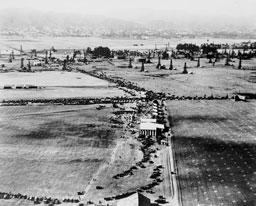
The corner of Wilshire and Fairfax, c. 1920
Opening at LACMA this Sunday, Vanity Fair Portraits: Photographs 1913-2008 spans the entirety of the magazine's history, stretching back to the launch of Dress & Vanity Fair in 1913. It was a pretty illustrious year for debuts.
In March, the legendary Armory show opened in New York, captivating and confusing critics and crowds alike. Causing the biggest stir were the galleries for cubist and futurist artists, whom former President Theodore Roosevelt described as "the lunatic fringe." Noting Duchamp's Nude Descending a Staircase, American Art News offered $10 to any reader who could identify either a nude or a staircase.
Plenty was also happening in Los Angeles in 1913. On November 6, the Los Angeles Museum of History, Science and Art opened in Exposition Park, and the Owens River Valley Aqueduct began bringing water to the city—a primary force in making this soon-to-be metropolis a livable region.
About three weeks after water and culture arrived in L.A., Cecil B. DeMille followed—fleeing the East Coast because Thomas Edison's Motion Picture Patents Company had monopolized the industry. In L.A., DeMille filmed his first feature, The Squaw Man; it was shot in a rural part of town—Sunset and Vine.
DeMille stayed in Hollywood for the rest of his career. An aviation enthusiast, he bought up land all over the city for airfields—one of which was located at the corner of Wilshire and Fairfax, right across the street from the future site of LACMA. Next time you drive by Johnie's or the 99 Cent Store, imagine DeMille taking off in his JL-6.



